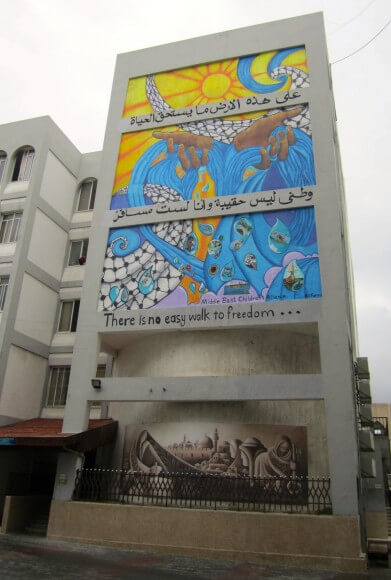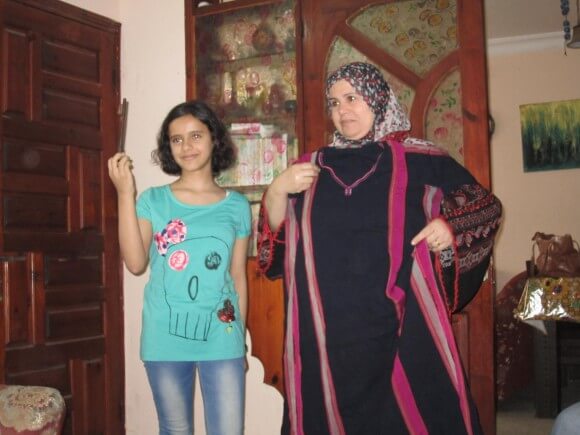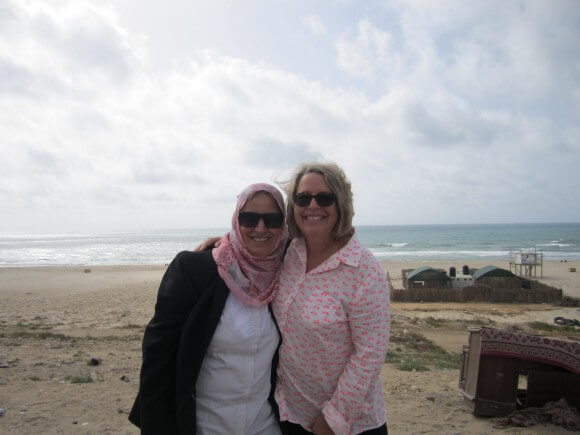One always leaves Gaza with a heavy heart.
The last time I visited Gaza was in 2001 as a member of an American Friends Service Committee (AFSC) delegation visiting our projects working with youth. I wrote about my short visit in an AFSC newsletter that I recently uncovered during a spring cleaning effort in our Chicago office. My impressions then were focused on the people of Gaza – their fortitude despite ongoing Israeli military occupation, their intense living conditions and lack of basic human rights, and their capacity to nurture hope and resilience.
In the intervening thirteen years between my visits, Gaza has added a half a million people to its small territory. Increasing numbers of people continue to rely on United Nations rations for feeding their families, and unemployment numbers remain high at 41%. Israeli soldiers no longer have a daily presence at checkpoints on Gaza streets, but continue to attack at will from the air and sea. Very few can get in or out of Gaza, only those with permits and those are very limited and granted artibrarily. Entry into Gaza at the Erez crossing has become even more impersonalized, with automated gates and narrow doorway passages where no human being is present. Israeli soldiers send orders to pass via microphones as they are stationed above the entry hall in glass sealed rooms. One must pass through a 500 meter (.3 mile) over-ground caged tunnel, with mounted automatic machine guns watching you from the distant wall, in order to make it to the small trailer that houses the Palestinian checkpoint. Perhaps in jest, the Palestinian check point includes a small café with the name “Al Awda” which means “The Return” in Arabic.
In 2001 I visited Gaza elementary schools where I met teachers who shared with me the challenges of teaching in the context of Israeli soldier raids and frequent attacks on the community. Second grade children explained what happened when the windows in their classroom were shattered by bullets and tear gas bombs, and showed us the drill of dropping to the floor with notebooks in hand. One teacher said, “My students can’t concentrate on their studies during the day, nor get any rest at night….Is this any way to live?” Teachers spoke of how they tried to create a “normal” atmosphere despite these conditions, and I admired the artwork they posted around their small classrooms in an attempt to create beauty.

On this visit I met college students, perhaps some of the same children I saw as young elementary students over a decade ago. At one of their universities (there are now eight in Gaza) a beautiful mural is painted with the message, “There is no easy walk to freedom.” It is exactly freedom that is the desire of every student we met.
Instead of demonstrating their routine of ducking for cover under desks, college students shared with us their stories of remaining strong despite the ongoing siege and military occupation of Gaza. One student told us that she gets up at 2 am to select and iron her clothes because there is no electricity when she would normally wake up for school. Since the Israeli army bombed Gaza’s main power plant, people in Gaza face regular electricity cuts, sometimes as much as 8 hours a day.
“I don’t want the Israeli military to determine what I wear every day to school. So I get up early to choose for myself,” she said proudly to our group. Another young woman said she became a painter because through art, “I can feel free.”
Other young people we talked to found creative writing as a useful outlet for coping with the stresses of life under constant threat of bombings and military siege. Several young Gaza authors were published recently in a collection of short stories called “Gaza Writes Back.”
One author, who was not permitted by Israel to travel to the U.S. to participate in a speaking tour co-organized by AFSC, asked how their stories were received by people living in the United States. I shared with her and others photos of the tour where, at least in some communities, their stories were heard.
The day before I left Chicago on my trip I had a complete stranger ask me why I was buying souvenirs and I told him I was going to Gaza. To my surprise he told me he understood that Palestinians in Gaza were “living in a big prison” and that I should tell them that not all Americans were oblivious to their suffering.
When I shared this experience with students we met with in a forum at their university, a few came up to me to say they had never seen an American show emotion for their lives under siege.
Young people in Gaza are understandably big fans of social media, including Facebook and Twitter. While power cuts may limit their ability to be online around the clock, they are sophisticated users and consumers of information shared on the internet. We were fortunate to be in Gaza when youth working with AFSC’s new youth program, “Palestinian Youth: Together For Change”, announced their new advocacy campaign that – not surprisingly – is focused on freedom of movement.

As in 2001, one feels great emotion from the experience of walking in an overcrowded refugee camp and being welcomed into the home of a family displaced from their original homes in 1948. On this visit we were offered tea and sweets from a family who fled the village of Majdel and now lives among the 87,000 residents of Beach/Al Shatti refugee camp.
My hands shook as I held the rusted key from the house Abu Yousef left behind and touched his wife’s grandmother’s dress she kept from the day she fled her village more than six decades ago. They showed us the small room beneath the stairs where they hid during the heaving bombing during Cast Lead in 2008 and said, “We are the fortunate ones that have stairs to hide underneath.” The graffiti on the wall outside their home announcing the wedding engagement of another young couple in the camp is a sign that life goes on.
One young man came up to me after our large group exchange at Al Azhar University to thank me for coming to Gaza. He had developed a stutter since the bombings in 2008 and was embarrassed to speak in front of his classmates. But with a clear voice he said to me, “Tell America we want to be free.”
With my heart heavy, I promised him I would.

This post originally appeared on the American Friends Service Committee website.


Last week Amnesty International USA sent a letter to key members of Congress regarding U.S. supplied military aid to Israel spurred by the ‘Trigger-happy Israeli army and police use reckless force in the West Bank‘ report published February 27, 2014 which documented cases of what appears may be war crimes by Israeli Occupying Forces.
Amnesty International USA is asking “the U.S. government to suspend transfers of munitions, weapons, crowd control devices, and military training to Israel. Such a suspension of U.S. arms transfers to Israel must be maintained until Israel puts in place effective mechanisms to ensure that these transfers will not be used to commit or facilitate violations under international humanitarian and human rights law.”
“From 2009 to 2018, the United States is scheduled to give Israel–the largest recipient of U.S. assistance–$30 billion in military aid. Through its illegal 44-year military occupation of the Palestinian West Bank, East Jerusalem, and Gaza Strip, Israel misuses U.S. weapons in violation of U.S. law to kill and injure Palestinian civilians, destroy Palestinian civilian infrastructure, blockade the Gaza Strip, and build illegal settlements in West Bank and East Jerusalem.”
Amnesty International has thoroughly documented specific US supplied weaponry, munitions, and equipment that have been directly linked to violations of international humanitarian and human rights law over the years saying:
“F-16s, Hellfire missiles, U.S. government-issued Caterpillar bulldozers, Apache helicopters and other weapons, munitions and equipment have been directly linked to violations of international humanitarian and human rights law by Israeli forces. Knowing this, the U.S. government is both violating its own law and policy, as well as being complicit in the commission of these human rights violations…”
http://thearabdailynews.com/2014/06/27/calling-us-congress-taxpayers-regarding-children-holy-land/
Thank you for sharing your experiences with us, Jennifer. I cannot fathom living with the enormous and unrelenting stress that Palestinians endure.
That mural is beautiful. I want them all to be free.